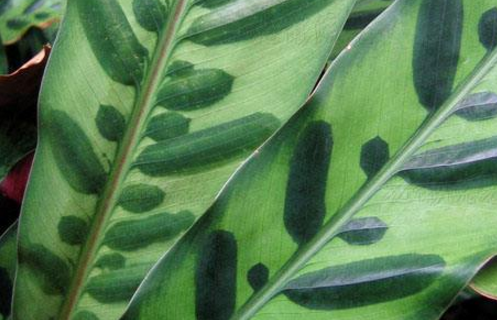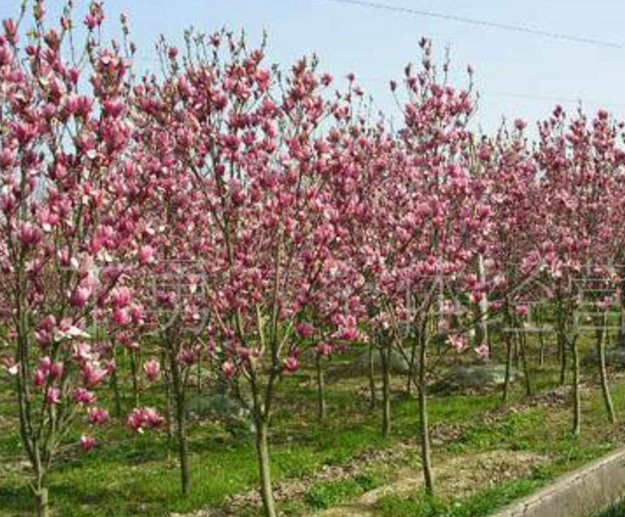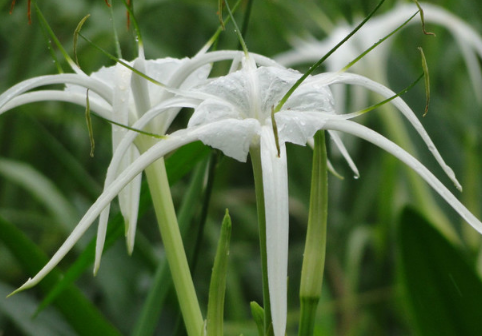Matters needing attention in the Culture of Arrow feather Bamboo Taro
1. Keep temperature
When raising Arrow feather Taro, you must pay attention to controlling the temperature, preferably between 18 and 25 ℃, which can ensure the fast growth of the plant as much as possible. If the summer weather is too hot, you should move to a cool environment to shade, lest the temperature is too high to dehydrate the plant. In winter, you also need to move the plant to the balcony and bask in the sun to keep the plant warm.

2. Environmental moisturizing
Arrow feather taro likes the moist growth environment, basically keeping the humidity around the plant at about 80%. The humid environment is more able to promote the growth of Arrow feather bamboo taro plants, so in maintenance, we must often spray water mist to the environment around the plant to moisturize. Especially in summer, in addition to watering, but also spray more water mist to avoid dryness.
Culture methods and matters needing attention of Arrow feather Taro
Latin name Ctenanthe oppenheimiana
Also known as red-feathered taro, double-line taro
The plant kingdom.
Family Bambusoideae
Genus Amorphophallus
Arrow feather bamboo taro (red feather bamboo taro, double line bamboo taro), bamboo taro family, pectinate taro genus, plant height up to 150 cm, leaf oblique, shaped like an arrow, hence the name arrow feather bamboo taro. It has high ornamental value. Place of origin, Brazil and other places. 1. Morphological characteristics.
Perennial evergreen herbaceous foliage plant. The height of the plant can reach more than 100 cm. The leaf is long oval to lanceolate, the leaf margin is obviously corrugated, on both sides of the main vein on the yellow-green leaf surface, the regular egg-shaped and oval dark green patches interact with each other into a pinnate arrangement. The leaves are 25cm in length and 8cm in width. The back and petiole of the leaf are purplish red, and the leaf extends upright upward. The leaf is oblique, shaped like an arrow, and there are fine hairs on the stem.
2. Growth environment
Originally from Brazil and Costa Rica. Like the warm, moist and semi-shaded Huanzhang. Avoid the hot summer sun exposure. It is suitable for loam which is loose, fertile and well drained.
3. Cultivation techniques.
Propagate in separate plants. In spring, combined with turning the basin and changing the soil, the root mass was removed and planted in the pot according to 3-5 trees per clump.
The pot culture soil was mixed with rotten leaf soil (or peat soil) and garden soil according to 1:1. Pay attention to keep the soil moist during the growing season, but do not accumulate water. In the hot and dry weather in summer and autumn, water should be sprayed to the leaves twice a day to facilitate the normal growth and luster of the leaves. Usually the amount of fertilizer required is not large, too much fertilization can easily cause the plant to grow too much, the leaves turn green and not bright, and even lodge and reduce the ornamental value, so fertilizer should be controlled and thin fertilizer can be applied once a month in the general growing season. Stop fertilizing at the end of autumn and control watering. Enter the room to protect against cold in October and keep the room temperature above 10 ℃ in winter.
[purpose] be placed at the entrance of the hall, on both sides of the corridor or in the corner of the conference room as decoration.
4. Disease and pest control
Red spider
There are few diseases and insect pests in double-line taro, but if the ventilation is poor and the air is dry, the damage caused by red spiders will also occur. Imidacloprid series of drugs will be used for spray control.
Anthrax
The anthracnose spot was yellowish brown, which formed small yellow spots near the edge of the leaf or in the center of the leaf at the initial stage of the disease, and gradually expanded, the color deepened, and turned to yellowish brown. The cause of the disease is high temperature and humidity, poor air circulation, and plants are placed too densely. There are many weeds and rotten leaves in the cultivation environment, too much nitrogen fertilizer is applied, and the plant grows too much. Young tissue is easy to get sick.
Strengthen fertilizer and water management, properly increase the application of phosphorus and potassium fertilizer, less nitrogen fertilizer, promote plant growth and enrich, and enhance their own resistance. Timely removal of diseased leaves and weeds to reduce the source of infection. Plant placement is not easy to be too dense, properly ventilated and transparent, reduce the humidity of the environment, can reduce the disease. Spray protection in the event of illness. The medications are: 50% carbendazim 600 times to 800 times, or 75% chlorothalonil 600 times to 800 times, 50% mancozeb 500 times to 600 times, every 7 to 10 days. All kinds of drugs should act alternately to prevent bacteria from developing drug resistance.
Does Arrow feather Taro absorb formaldehyde? can Arrow feather Taro purify the Air?
Most plants of the bamboo taro family have the function of absorbing formaldehyde and purifying the air, so in many public places, after decoration, they usually choose to plant some bamboo taro plants to absorb harmful substances in the air to achieve the purpose of air optimization. Arrow feather bamboo taro is a kind of bamboo taro family, which is easy to be confused with peacock taro and cat's eye taro in appearance.
Does Arrow feather Taro absorb formaldehyde?
Arrow feather taro has a certain role in absorbing formaldehyde, but relying solely on plants to absorb formaldehyde in the air is not enough and needs to be combined with other methods.
Can the arrow feather bamboo taro purify the air?
Arrow feather bamboo taro has a certain role of air purification, can absorb harmful substances in the air.
The efficacy and function of Arrow feather Bamboo Taro
1. The landscaping value of Arrow feather Bamboo Taro.
The leaves of Arrow feather bamboo taro have many colors, the ornamental effect is very strong, and its ability to adapt to the environment is relatively strong, so the figure of arrow feather bamboo taro can be seen in many places, such as in the courtyard, in the park, and on both sides of the road. its landscaping function is of high value, using piece planting, cluster planting or collocation with other plants for landscaping.
2. The interior decoration value of Arrow feather Taro.
Arrow feather bamboo taro has good shade resistance and beautiful leaves, so it is often planted as an interior decoration plant in hotels, shopping malls and other public places, and can also be placed at home as a small potted plant.
3. The medicinal value of Arrow feather Taro.
The rhizome of Arrow feather bamboo taro contains a certain amount of starch, which can not only be used as an edible material, but also has good medicinal value, such as diuresis, heat-clearing and so on.
4. Other values of Arrow feather Taro
The shape of Arrow feather bamboo taro is relatively beautiful, especially its colorful leaves, which is very suitable for illustration material. Arrow feather bamboo taro has a unique shape is that its leaves have many organized and eye-catching stripes, which is a very high-grade leaf cutting material. It can be directly used as a flower arrangement or as a lining material for flower arrangement.
Culture method of Arrow feather Bamboo Taro
1. Temperature
Arrow feather bamboo taro originally produced in Brazil and other places, is a tropical plant, prefer high temperature, humid environment, the best growth temperature should be maintained at about 25 degrees Celsius. Put it in a cool place in summer and guard against cold in winter.
2. Lighting
Arrow feather bamboo taro grows well under radiation and scattered light. If it is exposed to direct sunlight in summer, it is easy to cause burns to the leaves. If there is a phenomenon of leaf burns, it should be removed immediately and the burned leaves should be removed.
3. Moisture
The most suitable growth humidity of Arrow feather bamboo taro is about 80%, and the suitable air humidity is beneficial to the growth of living organisms. Too high or too low air humidity will cause the unhealthy growth of leaves. Water frequently during the growing season of plants, and often spray water on the leaves at high temperature. the best watering method is to spray water in the morning, pot soil at noon or in the afternoon, and the whole plant at night.
4. Cultivation substrate (basin soil)
Arrow feather bamboo taro soil requires fertile, good drainage, loose, generally use humus soil or coarse medium.
5. Fertilization
The fertilization principle of Arrow feather Taro: it is best to apply fertilizer frequently and thinly, about every two weeks or so during the peak growing season. Fertilizer is mainly nitrogen fertilizer, phosphate fertilizer and potassium fertilizer can also be, nitrogen fertilizer for Arrow feather taro can make the leaves more beautiful.
Arrow feather taro can also play a role in air purification, but it is not realistic to put a few plants in the house that can absorb harmful substances in order to completely remove formaldehyde. Only the combination of window ventilation and the use of formaldehyde-removing instruments or tools can ensure the improvement of air quality to a greater extent.
- Prev

Planting method of Magnolia
1, the choice of planting environment Magnolia like light, young trees are more resistant to shade, not resistant to strong light and western sun, too strong light or western sun, it is easy to burn trees. Magnolia can be planted in a side light-blocking environment, but it grows poorly under a big tree or in the shade, with thin trees, sparse branches, and small and yellowing leaves.
- Next

Control of diseases of water ghost banana
Anthracnose symptoms: Anthracnose is a fungal disease, mainly harmful to plant leaves, plant growth is very unfavorable. Control methods: timely cut off the burned leaves, spray 600 times of 40% multi-sulfur suspension agent before flowering in spring, pay attention to keep wet, do not apply nitrogen fertilizer
Related
- Fuxing push coffee new agricultural production and marketing class: lack of small-scale processing plants
- Jujube rice field leisure farm deep ploughing Yilan for five years to create a space for organic food and play
- Nongyu Farm-A trial of organic papaya for brave women with advanced technology
- Four points for attention in the prevention and control of diseases and insect pests of edible fungi
- How to add nutrient solution to Edible Fungi
- Is there any good way to control edible fungus mites?
- Open Inoculation Technology of Edible Fungi
- Is there any clever way to use fertilizer for edible fungus in winter?
- What agents are used to kill the pathogens of edible fungi in the mushroom shed?
- Rapid drying of Edible Fungi

